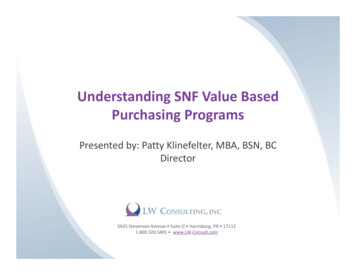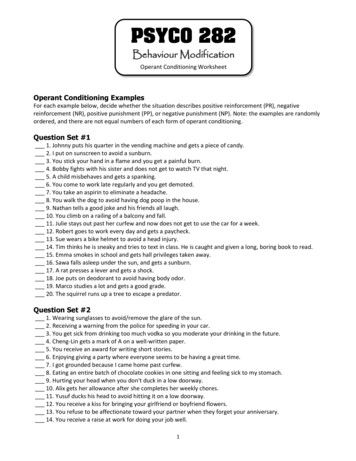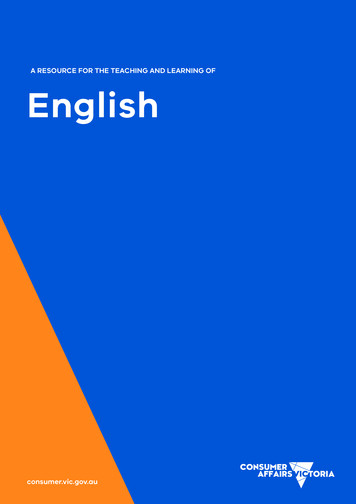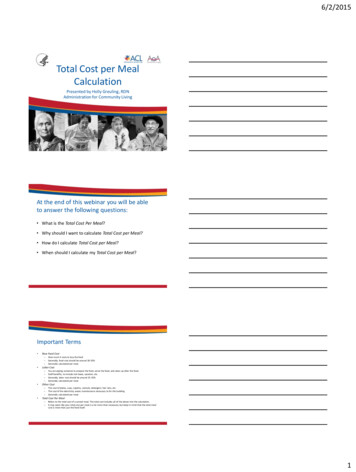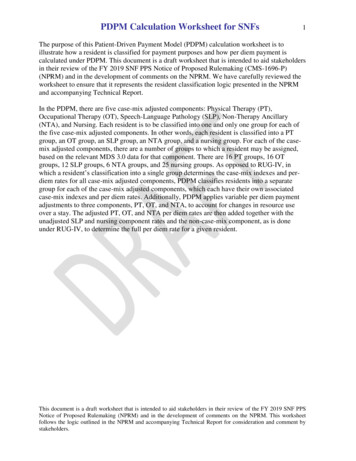
Transcription
PDPM Calculation Worksheet for SNFs1The purpose of this Patient-Driven Payment Model (PDPM) calculation worksheet is toillustrate how a resident is classified for payment purposes and how per diem payment iscalculated under PDPM. This document is a draft worksheet that is intended to aid stakeholdersin their review of the FY 2019 SNF PPS Notice of Proposed Rulemaking (CMS-1696-P)(NPRM) and in the development of comments on the NPRM. We have carefully reviewed theworksheet to ensure that it represents the resident classification logic presented in the NPRMand accompanying Technical Report.In the PDPM, there are five case-mix adjusted components: Physical Therapy (PT),Occupational Therapy (OT), Speech-Language Pathology (SLP), Non-Therapy Ancillary(NTA), and Nursing. Each resident is to be classified into one and only one group for each ofthe five case-mix adjusted components. In other words, each resident is classified into a PTgroup, an OT group, an SLP group, an NTA group, and a nursing group. For each of the casemix adjusted components, there are a number of groups to which a resident may be assigned,based on the relevant MDS 3.0 data for that component. There are 16 PT groups, 16 OTgroups, 12 SLP groups, 6 NTA groups, and 25 nursing groups. As opposed to RUG-IV, inwhich a resident’s classification into a single group determines the case-mix indexes and perdiem rates for all case-mix adjusted components, PDPM classifies residents into a separategroup for each of the case-mix adjusted components, which each have their own associatedcase-mix indexes and per diem rates. Additionally, PDPM applies variable per diem paymentadjustments to three components, PT, OT, and NTA, to account for changes in resource useover a stay. The adjusted PT, OT, and NTA per diem rates are then added together with theunadjusted SLP and nursing component rates and the non-case-mix component, as is doneunder RUG-IV, to determine the full per diem rate for a given resident.This document is a draft worksheet that is intended to aid stakeholders in their review of the FY 2019 SNF PPSNotice of Proposed Rulemaking (NPRM) and in the development of comments on the NPRM. This worksheetfollows the logic outlined in the NPRM and accompanying Technical Report for consideration and comment bystakeholders.
PDPM Calculation Worksheet for SNFs2Calculation of PDPM Cognitive LevelPDPMThe PDPM cognitive level is utilized in the SLP payment component of PDPM. One of fourPDPM cognitive performance levels is assigned based on the Brief Interview for MentalStatus (BIMS) or the staff assessment for PDPM cognitive level.STEP #1Determine the resident’s BIMS Summary Score on the MDS 3.0 based on the residentinterview. Instructions for completing the BIMS are in Chapter 3, Section C. The BIMSinvolves the following items:C0200 Repetition of three wordsC0300 Temporal orientationC0400 RecallItem C0500 provides a BIMS Summary Score that ranges from 00 to 15. If the residentinterview is not successful, then the BIMS Summary Score will equal 99.Calculate the resident’s PDPM cognitive level using the following mapping:Table 1: Calculation of PDPM Level from BIMS:PDPM Cognitive LevelBIMSScoreCognitively Intact13-15Mildly Impaired8-12Moderately Impaired0-7Severely Impaired-PDPM Cognitive Level:If the resident’s Summary Score is 99 (resident interview not successful) or the SummaryScore is blank (resident interview not attempted and skipped) or the Summary Score has adash value (not assessed), then proceed to Step #2 to use the staff assessment for PDPMcognitive level.This document is a draft worksheet that is intended to aid stakeholders in their review of the FY 2019 SNF PPSNotice of Proposed Rulemaking (NPRM) and in the development of comments on the NPRM. This worksheetfollows the logic outlined in the NPRM and accompanying Technical Report for consideration and comment bystakeholders.
PDPM Calculation Worksheet for SNFs3STEP #2If the resident’s Summary Score is 99 or the Summary Score is blank or has a dash value,then determine the resident’s cognitive status based on the staff assessment for PDPMcognitive level using the following steps:A) The resident classifies as severely impaired if one of following conditions exist:a. Comatose (B0100 1) and completely dependent or activity did not occur atadmission (GG0130A1, GG0130C1, GG0170B1, GG0170C1, GG0170D1,GG0170E1, and GG0170F1, all equal 01, 09, or 88).b. Severely impaired cognitive skills for daily decision making (C1000 3).B) If the resident is not severely impaired based on Step A, then determine the resident’sBasic Impairment Count and Severe Impairment Count.For each of the conditions below that applies, add one to the Basic Impairment Count.a. In Cognitive Skills for Daily Decision Making, the resident has modifiedindependence or is moderately impaired (C1000 1 or 2).b. In Makes Self Understood, the resident is usually understood, sometimesunderstood, or rarely/never understood (B0700 1, 2, or 3).c. Based on the Staff Assessment for Mental Status, resident has memory problem(C0700 1).Sum a., b., and c. to get the Basic Impairment Count:For each of the conditions below that applies, add one to the Severe Impairment Count.a. In Cognitive Skills for Daily Decision Making, resident is moderately impaired(C1000 2).b. In Makes Self Understood, resident is sometimes understood or rarely/neverunderstood (B0700 2 or 3).Sum a. and b. to get the Severe Impairment Count:C) The resident classifies as moderately impaired if the Severe Impairment Count is 1 or 2and the Basic Impairment Count is 2 or 3.This document is a draft worksheet that is intended to aid stakeholders in their review of the FY 2019 SNF PPSNotice of Proposed Rulemaking (NPRM) and in the development of comments on the NPRM. This worksheetfollows the logic outlined in the NPRM and accompanying Technical Report for consideration and comment bystakeholders.
PDPM Calculation Worksheet for SNFs4D) The resident classifies as mildly impaired if the Severe Impairment Count is 0 and theBasic Impairment Count is 1, 2, or 3.E) The resident classifies as cognitively intact if both the Severe Impairment Count andBasic Impairment Count are 0.PDPM Cognitive Level:This document is a draft worksheet that is intended to aid stakeholders in their review of the FY 2019 SNF PPSNotice of Proposed Rulemaking (NPRM) and in the development of comments on the NPRM. This worksheetfollows the logic outlined in the NPRM and accompanying Technical Report for consideration and comment bystakeholders.
PDPM Calculation Worksheet for SNFs5Payment Component: PTPDPMSTEP #1Determine the resident’s primary diagnosis clinical category using ICD-10-CM and ICD-10-PCScodes recorded in MDS item I8000. To do so, refer to the PDPM clinical category mapping(available at ent/SNFPPS/therapyresearch.html), which maps a resident’s primary diagnosis as recorded on the firstline of MDS item I8000 to the 10 PDPM primary diagnosis clinical categories. Some ICD-10-CMcodes map to more than one clinical category depending on inpatient procedure history. For thesecodes, a resident may be categorized into a surgical clinical category if the resident received asurgical procedure during the inpatient stay that relates to the primary reason for the Part A SNFstay as indicated by the ICD-10-PCS code in the second line of item I8000. Next, determine theresident’s PT clinical category based on the mapping shown below.Table 2: PT Clinical CategoryPrimary Diagnosis Clinical CategoryPT Clinical CategoryMajor Joint Replacement or Spinal SurgeryOrthopedic Surgery (Except Major JointReplacement or Spinal Surgery)Non-Orthopedic SurgeryMajor Joint Replacement or Spinal SurgeryAcute InfectionsMedical ManagementCardiovascular and CoagulationsMedical ManagementPulmonaryMedical ManagementNon-Surgical Orthopedic/MusculoskeletalOther OrthopedicAcute NeurologicAcute NeurologicCancerMedical ManagementMedical ManagementMedical ManagementOther OrthopedicNon-Orthopedic SurgeryPT Clinical Category:STEP #2Calculate the resident’s Function Score for PT payment. Use the following table to determine theFunction Score for Eating Admission Performance (GG0130A1), Oral Hygiene AdmissionPerformance (GG0130B1), Toileting Hygiene Admission Performance (GG0130C1), Sit to LyingAdmission Performance (GG0170B1), Lying to Sitting on Side of Bed Admission Performance(GG0170C1), Sit to Stand Admission Performance (GG0170D1), Chair/Bed-to-Chair TransferAdmission Performance (GG0170E1), and Toilet Transfer Admission Performance (GG0170F1).Determine if the resident can walk using item GG0170H1. If the resident cannot walkThis document is a draft worksheet that is intended to aid stakeholders in their review of the FY 2019 SNF PPS Noticeof Proposed Rulemaking (NPRM) and in the development of comments on the NPRM. This worksheet follows the logicoutlined in the NPRM and accompanying Technical Report for consideration and comment by stakeholders.
PDPM Calculation Worksheet for SNFs6(GG0170H1 0 or 1), then the Function Score for Walk 50 Feet with Two Turns (GG0170J1) andWalk 150 Feet (GG0170K1) is 0. If the resident can walk (GG0170H1 2), then determine theFunction Score for Walk 50 Feet with Two Turns (GG0170J1) and Walk 150 Feet (GG0170K1)using the following table.Table 3: Function Score for PT PaymentAdmissionPerformance(Column 1) 05, 0604030201, 07, 09, 88Function Score 43210Enter the Function Score for each item:EatingEating Function Score:Oral HygieneOral Hygiene Function Score:Toileting HygieneToileting Hygiene Function Score:Bed MobilitySit to Lying Function Score:Lying to Sitting on Side of Bed Function Score:TransferSit to Stand Function Score:Chair/Bed-to-Chair Function Score:Toilet Transfer Function Score:WalkingWalk 50 Feet with Two Turns Function Score:Walk 150 Feet Function Score:Next, calculate the average Function Score for the two bed mobility items, the three transferThis document is a draft worksheet that is intended to aid stakeholders in their review of the FY 2019 SNF PPS Noticeof Proposed Rulemaking (NPRM) and in the development of comments on the NPRM. This worksheet follows the logicoutlined in the NPRM and accompanying Technical Report for consideration and comment by stakeholders.
PDPM Calculation Worksheet for SNFs7items, and the two walking items as follows: Average the Function Scores for Sit to Lying andLying to Sitting on Side of Bed.1 Average the Function Scores for Sit to Stand, Chair/Bed-toChair and Toilet Transfer.2 Average the Function Scores for Walk 50 Feet with Two Turns andWalk 150 Feet.3 Enter the average bed mobility, transfer, and walking Function Scores below.Average Bed Mobility Function Score:Average Transfer Function Score:Average Walking Function Score:Calculate the sum of the following Function Scores: Eating Function Score, Oral HygieneFunction Score, Toileting Hygiene Function Score, Average Bed Mobility Function Score,Average Transfer Function Score, and Average Walking Function Score. Finally, round this sumto the nearest integer. This is the PDPM Function Score for PT Payment. The PDPM FunctionScore for PT Payment ranges from 0 through 24.PT FUNCTION SCORE:STEP #3Using the responses from Steps 1 and 2 above, determine the resident’s PT group using the tablebelow.Table 4: PT Case-Mix GroupsSection GG FunctionScorePT Case-Mix GroupMajor Joint Replacement or Spinal Surgery0-5TAMajor Joint Replacement or Spinal Surgery6-9TBMajor Joint Replacement or Spinal Surgery10-23TCMajor Joint Replacement or Spinal Surgery24TDOther Orthopedic0-5TEOther Orthopedic6-9TFOther Orthopedic10-23TGOther Orthopedic24THMedical Management0-5TIMedical Management6-9TJClinical Category1Calculate the sum of the Function Scores for Sit to Lying and Lying to Sitting on Side of Bed. Divide this sum by 2.This is the Average Bed Mobility Function Score.2Calculate the sum of the Function Scores for Sit to Stand, Chair/Bed-to-Chair, and Toilet Transfer. Divide this sumby 3. This is the Average Bed Mobility Function Score.3Calculate the sum of the Function Scores for Walk 50 Feet with Two Turns and Walk 150 Feet. Divide this sum by 2.This is the Average Walking Function Score.This document is a draft worksheet that is intended to aid stakeholders in their review of the FY 2019 SNF PPS Noticeof Proposed Rulemaking (NPRM) and in the development of comments on the NPRM. This worksheet follows the logicoutlined in the NPRM and accompanying Technical Report for consideration and comment by stakeholders.
PDPM Calculation Worksheet for SNFs8Section GG FunctionScorePT Case-Mix GroupMedical Management10-23TKMedical Management24TLNon-Orthopedic Surgery and Acute Neurologic0-5TMNon-Orthopedic Surgery and Acute Neurologic6-9TNNon-Orthopedic Surgery and Acute Neurologic10-23TONon-Orthopedic Surgery and Acute Neurologic24TPClinical CategoryPDPM PT Classification:This document is a draft worksheet that is intended to aid stakeholders in their review of the FY 2019 SNF PPS Noticeof Proposed Rulemaking (NPRM) and in the development of comments on the NPRM. This worksheet follows the logicoutlined in the NPRM and accompanying Technical Report for consideration and comment by stakeholders.
PDPM Calculation Worksheet for SNFs9Payment Component: OTPDPMSTEP #1Determine the resident’s primary diagnosis clinical category using ICD-10-CM and ICD-10-PCScodes recorded in MDS item I8000. To do so, refer to the PDPM clinical category mapping(available at ent/SNFPPS/therapyresearch.html), which maps a resident’s primary diagnosis as recorded on the firstline of MDS item I8000 to the 10 PDPM primary diagnosis clinical categories. Some ICD-10-CMcodes map to more than one clinical category depending on inpatient procedure history. For thesecodes, a resident may be categorized into a surgical clinical category if the resident received asurgical procedure during the inpatient stay that relates to the primary reason for the Part A SNFstay as indicated by the ICD-10-PCS code in the second line of item I8000.Next, determine the resident’s OT clinical category based on the mapping shown below.Table 5: OT Clinical CategoryPrimary Diagnosis Clinical CategoryPT Clinical CategoryMajor Joint Replacement or Spinal SurgeryOrthopedic Surgery (Except Major JointReplacement or Spinal Surgery)Non-Orthopedic SurgeryMajor Joint Replacement or Spinal SurgeryAcute InfectionsMedical ManagementCardiovascular and CoagulationsMedical ManagementPulmonaryMedical ManagementNon-Surgical Orthopedic/MusculoskeletalOther OrthopedicAcute NeurologicAcute NeurologicCancerMedical ManagementMedical ManagementMedical ManagementOther OrthopedicNon-Orthopedic SurgeryOT Clinical Category:STEP #2Calculate the resident’s Function Score for OT payment. Use the following table to determine theFunction Score for Eating Admission Performance (GG0130A1), Oral Hygiene AdmissionPerformance (GG0130B1), Toileting Hygiene Admission Performance (GG0130C1), Sit to LyingAdmission Performance (GG0170B1), Lying to Sitting on Side of Bed Admission Performance(GG0170C1), Sit to Stand Admission Performance (GG0170D1), Chair/Bed-to-Chair TransferAdmission Performance (GG0170E1), and Toilet Transfer Admission Performance (GG0170F1).This document is a draft worksheet that is intended to aid stakeholders in their review of the FY 2019 SNF PPS Noticeof Proposed Rulemaking (NPRM) and in the development of comments on the NPRM. This worksheet follows the logicoutlined in the NPRM and accompanying Technical Report for consideration and comment by stakeholders.
PDPM Calculation Worksheet for SNFs10Determine if the resident can walk using item GG0170H1. If the resident cannot walk(GG0170H1 0 or 1), then the Function Score for Walk 50 Feet with Two Turns (GG0170J1) andWalk 150 Feet (GG0170K1) is 0. If the resident can walk (GG0170H1 2), then determine theFunction Score for Walk 50 Feet with Two Turns (GG0170J1) and Walk 150 Feet (GG0170K1)using the following table.Table 6: Function Score for OT PaymentAdmissionPerformance(Column 1) 05, 0604030201, 07, 09, 88Function Score 43210Enter the Function Score for each item:EatingEating Function Score:Oral HygieneOral Hygiene Function Score:Toileting HygieneToileting Hygiene Function Score:Bed MobilitySit to Lying Function Score:Lying to Sitting on Side of Bed Function Score:TransferSit to Stand Function Score:Chair/Bed-to-Chair Function Score:Toilet Transfer Function Score:WalkingWalk 50 Feet with Two Turns Function Score:Walk 150 Feet Function Score:Next, calculate the average Function Score for the two bed mobility items, the three transferitems, and the two walking items as follows: Average the Function Scores for Sit to Lying andThis document is a draft worksheet that is intended to aid stakeholders in their review of the FY 2019 SNF PPS Noticeof Proposed Rulemaking (NPRM) and in the development of comments on the NPRM. This worksheet follows the logicoutlined in the NPRM and accompanying Technical Report for consideration and comment by stakeholders.
PDPM Calculation Worksheet for SNFs11Lying to Sitting on Side of Bed.4 Average the Function Scores for Sit to Stand, Chair/Bed-toChair and Toilet Transfer.5 Average the Function Scores for Walk 50 Feet with Two Turns andWalk 150 Feet.6 Enter the average bed mobility, transfer, and walking Function Scores below.Average Bed Mobility Function Score:Average Transfer Function Score:Average Walking Function Score:Calculate the sum of the following scores: Eating Function Score, Oral Hygiene Function Score,Toileting Hygiene Function Score, Average Bed Mobility Score, Average Transfer Score, andAverage Walking Score. Finally, round this sum to the nearest integer. This is the PDPMFunction Score for OT Payment. The PDPM Function Score for OT Payment ranges from 0through 24.OT FUNCTION SCORE:STEP #3Using the responses from Steps 1 and 2 above, determine the resident’s OT group using the tablebelow. The resident should be assigned to the same case-mix group for PT and OT.Table 7: OT Case-Mix GroupsSection GG FunctionScoreOT Case-Mix GroupMajor Joint Replacement or Spinal Surgery0-5TAMajor Joint Replacement or Spinal Surgery6-9TBMajor Joint Replacement or Spinal Surgery10-23TCMajor Joint Replacement or Spinal Surgery24TDOther Orthopedic0-5TEOther Orthopedic6-9TFOther Orthopedic10-23TGOther Orthopedic24THMedical Management0-5TIMedical Management6-9TJClinical Category4Calculate the sum of the Function Scores for Sit to Lying and Lying to Sitting on Side of Bed. Divide this sum by 2.This is the Average Bed Mobility Function Score.5Calculate the sum of the Function Scores for Sit to Stand, Chair/Bed-to-Chair, and Toilet Transfer. Divide this sumby 3. This is the Average Bed Mobility Function Score.6Calculate the sum of the Function Scores for Walk 50 Feet with Two Turns and Walk 150 Feet. Divide this sum by 2.This is the Average Walking Function Score.This document is a draft worksheet that is intended to aid stakeholders in their review of the FY 2019 SNF PPS Noticeof Proposed Rulemaking (NPRM) and in the development of comments on the NPRM. This worksheet follows the logicoutlined in the NPRM and accompanying Technical Report for consideration and comment by stakeholders.
PDPM Calculation Worksheet for SNFs12Section GG FunctionScoreOT Case-Mix GroupMedical Management10-23TKMedical Management24TLNon-Orthopedic Surgery and Acute Neurologic0-5TMNon-Orthopedic Surgery and Acute Neurologic6-9TNNon-Orthopedic Surgery and Acute Neurologic10-23TONon-Orthopedic Surgery and Acute Neurologic24TPClinical CategoryPDPM OT Classification:This document is a draft worksheet that is intended to aid stakeholders in their review of the FY 2019 SNF PPS Noticeof Proposed Rulemaking (NPRM) and in the development of comments on the NPRM. This worksheet follows the logicoutlined in the NPRM and accompanying Technical Report for consideration and comment by stakeholders.
PDPM Calculation Worksheet for SNFs13Payment Component: SLPPDPMSTEP #1Determine the resident’s primary diagnosis clinical category using ICD-10-CM and ICD-10-PCScodes recorded in MDS item I8000. To do so, refer to the PDPM clinical category mapping(available at ent/SNFPPS/therapyresearch.html), which maps a resident’s primary diagnosis as recorded on the firstline of MDS item I8000 to the 10 PDPM primary diagnosis clinical categories. Some ICD-10-CMcodes map to more than one clinical category depending on inpatient procedure history. For thesecodes, a resident may be categorized into a surgical clinical category if the resident received asurgical procedure during the inpatient stay that relates to the primary reason for the Part A SNFstay as indicated by the ICD-10-PCS code in the second line of item I8000. The primary diagnosisclinical category should match the primary diagnosis clinical category chosen for the PT and OTcomponents. The final SLP clinical category, however, may be different from the final PT and OTclinical categories.Next, determine the resident’s SLP clinical category based on the mapping shown below.Table 8: SLP Clinical CategoryPrimary Diagnosis Clinical CategorySLP Clinical CategoryMajor Joint Replacement or Spinal SurgeryOrthopedic Surgery (Except Major JointReplacement or Spinal Surgery)Non-Orthopedic SurgeryNon-NeurologicAcute InfectionsNon-NeurologicCardiovascular and on-Surgical Orthopedic/MusculoskeletalNon-NeurologicAcute NeurologicAcute NeurologicCancerNon-NeurologicMedical icSLP Clinical Category:STEP #2Determine whether the resident has one or more SLP-related comorbidities. To do so, examinethe services and conditions in the table below. If any of these items is indicated as present, theresident has an SLP-related comorbidity. For comorbidities that are recorded in Section I8000 ofthe MDS, use the mapping below to check if the specific ICD-10-CM codes corresponding to thecondition are coded in Section I8000.This document is a draft worksheet that is intended to aid stakeholders in their review of the FY 2019 SNF PPS Noticeof Proposed Rulemaking (NPRM) and in the development of comments on the NPRM. This worksheet follows the logicoutlined in the NPRM and accompanying Technical Report for consideration and comment by stakeholders.
PDPM Calculation Worksheet for SNFs14Table 9: SLP-Related ComorbiditiesMDS ItemDescriptionI4300AphasiaI4500CVA, TIA, or StrokeI4900Hemiplegia or HemiparesisI5500Traumatic Brain InjuryI8000Laryngeal CancerI8000ApraxiaI8000DysphagiaI8000ALSI8000Oral CancersI8000Speech and Language DeficitsO0100E2Tracheostomy Care While a ResidentO0100F2Ventilator or Respirator While a ResidentTable 10: Mapping of ICD-10-CM Codes to SLP-Related ComorbiditiesSLP-Related ComorbidityICD-10CM CodeALSG12.21Amyotrophic lateral sclerosisApraxiaI69.990Apraxia following unspecified cerebrovascular diseaseDysphagiaI69.991Dysphagia following unspecified cerebrovascular diseaseLaryngeal CancerC32.0Malignant neoplasm of glottisLaryngeal CancerC32.1Malignant neoplasm of supraglottisLaryngeal CancerC32.2Malignant neoplasm of subglottisLaryngeal CancerC32.3Malignant neoplasm of laryngeal cartilageLaryngeal CancerC32.8Malignant neoplasm of other specified sites of larynxLaryngeal CancerC32.9Malignant neoplasm of larynx, unspecifiedOral CancersC00.0Malignant neoplasm of external upper lipOral CancersC00.1Malignant neoplasm of external lower lipOral CancersC00.3Malignant neoplasm of upper lip, inner aspectOral CancersC00.4Malignant neoplasm of lower lip, inner aspectOral CancersC00.5Malignant neoplasm of lip, unspecified, inner aspectOral CancersC00.6Malignant neoplasm of commissure of lip, unspecifiedOral CancersC00.8Malignant neoplasm of overlapping sites of lipOral CancersC00.2Malignant neoplasm of external lip, unspecifiedOral CancersC00.9Malignant neoplasm of lip, unspecifiedOral CancersC01Malignant neoplasm of base of tongueOral CancersC02.0Malignant neoplasm of dorsal surface of tongueOral CancersC02.1Malignant neoplasm of border of tongueDescriptionThis document is a draft worksheet that is intended to aid stakeholders in their review of the FY 2019 SNF PPS Noticeof Proposed Rulemaking (NPRM) and in the development of comments on the NPRM. This worksheet follows the logicoutlined in the NPRM and accompanying Technical Report for consideration and comment by stakeholders.
PDPM Calculation Worksheet for SNFsSLP-Related ComorbidityICD-10CM CodeOral CancersC02.2Malignant neoplasm of ventral surface of tongueOral CancersC02.3Malignant neoplasm of anterior two-thirds of tongue, part unspecifiedOral CancersC02.8Malignant neoplasm of overlapping sites of tongueOral CancersC02.4Malignant neoplasm of lingual tonsilOral CancersC02.8Malignant neoplasm of overlapping sites of tongueOral CancersC02.9Malignant neoplasm of tongue, unspecifiedOral CancersC03.0Malignant neoplasm of upper gumOral CancersC03.1Malignant neoplasm of lower gumOral CancersC03.9Malignant neoplasm of gum, unspecifiedOral CancersC03.9Malignant neoplasm of gum, unspecifiedOral CancersC04.0Malignant neoplasm of anterior floor of mouthOral CancersC04.1Malignant neoplasm of lateral floor of mouthOral CancersC04.8Malignant neoplasm of overlapping sites of floor of mouthOral CancersC04.9Malignant neoplasm of floor of mouth, unspecifiedOral CancersC09.9Malignant neoplasm of tonsil, unspecifiedOral CancersC09.8Malignant neoplasm of overlapping sites of tonsilOral CancersC09.0Malignant neoplasm of tonsillar fossaOral CancersC09.1Malignant neoplasm of tonsillar pillar (anterior) (posterior)Oral CancersC10.0Malignant neoplasm of valleculaOral CancersC10.1Malignant neoplasm of anterior surface of epiglottisOral CancersC10.8Malignant neoplasm of overlapping sites of oropharynxOral CancersC10.2Malignant neoplasm of lateral wall of oropharynxOral CancersC10.3Malignant neoplasm of posterior wall of oropharynxOral CancersC10.4Malignant neoplasm of branchial cleftOral CancersC10.8Malignant neoplasm of overlapping sites of oropharynxOral CancersC10.9Malignant neoplasm of oropharynx, unspecifiedOral CancersC14.0Malignant neoplasm of pharynx, unspecifiedOral CancersC14.2Malignant neoplasm of waldeyer's ringOral CancersC14.8Malignant neoplasm of overlapping sites of lip, oral cavity and pharynxOral CancersC14.8Malignant neoplasm of overlapping sites of lip, oral cavity and pharynxOral CancersC06.0Malignant neoplasm of cheek mucosaOral CancersC06.1Malignant neoplasm of vestibule of mouthOral CancersC05.0Malignant neoplasm of hard palateOral CancersC05.1Malignant neoplasm of soft palateOral CancersC05.2Malignant neoplasm of uvulaOral CancersC05.9Malignant neoplasm of palate, unspecifiedOral CancersC05.8Malignant neoplasm of overlapping sites of palateOral CancersC06.2Malignant neoplasm of retromolar areaOral CancersC06.89Malignant neoplasm of overlapping sites of other parts of mouth15DescriptionThis document is a draft worksheet that is intended to aid stakeholders in their review of the FY 2019 SNF PPS Noticeof Proposed Rulemaking (NPRM) and in the development of comments on the NPRM. This worksheet follows the logicoutlined in the NPRM and accompanying Technical Report for consideration and comment by stakeholders.
PDPM Calculation Worksheet for SNFsSLP-Related ComorbidityICD-10CM CodeOral CancersC06.80Malignant neoplasm of overlapping sites of unspecified parts of mouthOral CancersC06.9Malignant neoplasm of mouth, unspecifiedI69.928Other speech and language deficits following unspecified cerebrovasculardiseaseI69.920Aphasia following unspecified cerebrovascular diseaseI69.921Dysphasia following unspecified cerebrovascular diseaseI69.922Dysarthria following unspecified cerebrovascular diseaseI69.923Fluency disorder following unspecified cerebrovascular diseaseI69.928Other speech and language deficits following unspecified cerebrovasculardiseaseSpeech and LanguageDeficitsSpeech and LanguageDeficitsSpeech and LanguageDeficitsSpeech and LanguageDeficitsSpeech and LanguageDeficitsSpeech and LanguageDeficits16DescriptionPresence of one or more SLP-related comorbidities? (Yes/No)STEP #3Determine whether resident has a cognitive impairment. Calculate the resident’s PDPMcognitive level, as described previously. If the PDPM cognitive level is cognitively intact, thenthe resident does not have a cognitive impairment. Otherwise, if the resident is assessed asmildly, moderately, or severely impaired, then the resident classifies as cognitively impaired.Presence of Cognitive Impairment? (Yes/No)STEP #4Determine how many of the following conditions are present:a. Based on Step 1, the resident is classified in the Acute Neurologic clinical category.b. Based on Step 2, the resident has one or more SLP-related comorbidities.c. Based on Step 3, the resident has a cognitive impairment.Number of conditions present:STEP #5Determine whether the resident has a swallowing disorder using item K0100. If any of theconditions indicated in items K0100A through K0100D is present, then the resident hasswallowing disorder. If none of these conditions is present, the resident does not have aswallowing disorder for purposes of this calculation.Presence of Swallowing Disorder? (Yes/No)This document is a draft worksheet that is intended to aid stakeholders in their review of the FY 2019 SNF PPS Noticeof Proposed Rulemaking (NPRM) and in the development of comments on the NPRM. This worksheet follows the logicoutlined in the NPRM and accompanying Technical Report for consideration and comment by stakeholders.
PDPM Calculation Worksheet for SNFs17STEP #6Determine whether the resident has a mechanically altered diet. If K0510C2 (mechanically altereddiet while a resident) is checked, then the resident has a mechanically altered diet.Presence of Mechanically Altered Diet? (
PDPM Calculation Worksheet for SNFs 4 This document is a draft worksheet that is intended to aid stakeholders in their review of the FY 2019 SNF PPS


